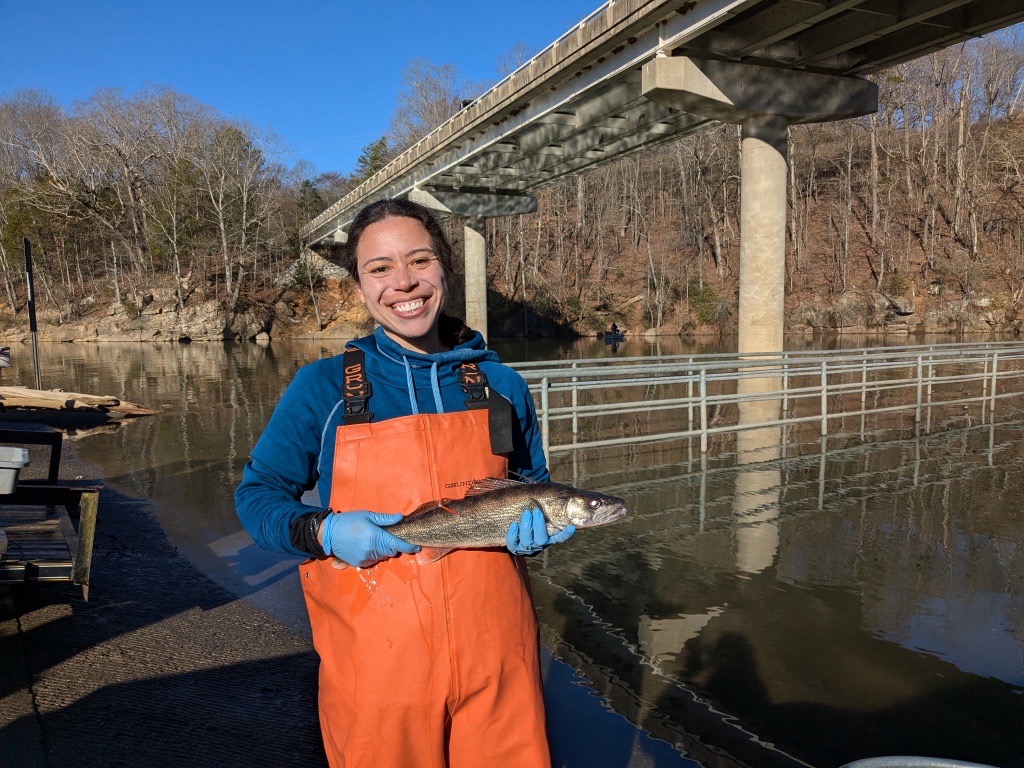
Graduate teaching assistant and master’s student Brittnany Graham spoke about the Watts Bar walleye project she’s working on with the Tennessee Wildlife Resources Agency and how anglers can help with her research for episode 36 of our Step Outside series. You can watch the full interview below or on our YouTube channel. Find more information about her project here.
Transcript:
I wanted to have you on because you’re working on a project on the walleye in Watts Bar Reservoir. Would you mind just telling us about that project?
First, I want to say thank you so much for having me today. I’m really excited. My project is focusing on the movement and habitat use and spawning of walleye in Watts Bar Reservoir. Prior to 2011, the Tennessee Wildlife Resources Agency was stocking a close relative to walleye. It’s called sauger, but due to some inconsistent spawning years, they made the decision in 2011 to switch to stocking walleye. However, they generally didn’t know where they go or what kind of habitats they use. There wasn’t a lot of research focused on walleye, but what I do is I use acoustic telemetry, a combination of passive and active acoustic telemetry, to kind of track where they go during the summer months, during spawning seasons, and throughout the year.
Because I’m not very familiar with it, could you explain to me what acoustic telemetry is?
Acoustic telemetry, in a nutshell, is the use of sound to track aquatic animals. Because once they go into the water, we don’t generally know where they go, right? We, or I, surgically implant a little acoustic transmitter. To give it context, it’s like if you were to go through a toll booth and they have cameras and they’re looking, or you have an EZ pass. They’re able to track, generally, where you are. An acoustic transmitter just sends out a signal every 60 to 120 seconds, and these acoustic receivers are passive, but they’re all throughout Watts Bar. They’re stationary. Once we release the fish back into Watts Bar as they’re passing a receiver in that moment of time, we know where they’re at. Then over the year of my study, I’ll be able to generally look at trends of movement, where they like to go hang out, and what times of year they like to inhabit specific areas.
What is the main goal behind this project?
Earlier I mentioned it, but I’ve been working very closely with TWRA, and my role as a researcher is collecting data. Once I analyze it, I’ll be passing that information on to TWRA. Overall, it helps inform their management goals so that in the future anglers are able to keep fishing for walleye. The recreational walleye fishery here is starting to become more popular, and we want to ensure that there are plenty of walleye for anglers to keep fishing, and these stocking practices are helping maintain a healthy fishery.
Speaking of anglers, they can also help with your research. What is your message to them?
My message to anglers: keep fishing. That’s what we want you to do, but if you do catch a walleye with an orange loop tag, I specifically picked orange because they’re very bright. You can’t miss it, and it’s also associated with the university. My phone number is on it, so if you could give me a call and just tell me generally where you’re at, the number of the loop tag on there. We’re able to track and see how many fish are being fished out, potentially, and also help with the study. Just return if you’re able to. Just return the fish into the system so we can keep collecting data to help better inform. That way we can all keep fishing in the future.
It’s a two-year project, correct? How far into the project are you right now?
In February in conjunction with TWRA, I was able to collect and tag 150 fish out of Watts Bar and its two tributaries, the Clinch and the Emory River, which was so much fun. We’ve got all of our fish tagged. All of my receivers are out in Watts Bar collecting data. They’re on 24/7, so they’re always collecting data, and now I have what’s called like these egg mats out just in some areas where we think that walleye are spawning. I’m pretty far into it in terms of just having all of my tags and receivers out, but I’ll be doing my first big round of like information downloads from those receivers here shortly.
This is also part of my study. During the summer months to identify some critical habitat cool water pockets for walleye, we use what’s called active tracking. This is called a VR-100. We’ll drop this in the water. This is a hydrophone, and the passive acoustic receivers work in a very similar way. There’s a receiving end of the hydrophone that will pick up any detections from fish in the area in real time so while we’re kind of drifting down in Watts Bar we’ll be able to kind of hear where the fish are, and the VR-100 will tell us like what the tag number is and generally how many fish are in the area depending on how many tag returns that we get back. This is another way that we’re able to, like I said, identify critical habitat for walleye during the summer months because walleye are a cool water species. Although they are native to Tennessee, we sit more towards that southern end of their range, and it gets really warm here in the summer, so they kind of got to find a cool place to hang out.
How did you get into this field of study?
I actually started out in marine biology when I was in undergrad, but then I worked at Southern Illinois University for a little while. There I was looking at the movement of an invasive carp called silver carp, and I absolutely fell in love with movement ecology. I thought it was so cool that you were able to go out and kind of track where the fish go and where they hang out and how much it can be like an interagency collaboration. That’s what I really love about it, and I took off from there. Like I said, I just love it, but when a friend passed along the announcement that Dr. Izzo, my advisor, had released, I knew I had to at least try.
What’s your goal once you receive your master’s?
Hopefully, I would like to be a project manager for either a state or a federal agency, but I really just love movement ecology, and I just want to be able to continue to conduct research that helps generate a healthy and sustainable fishery in the future. I would like to be within the general southern Appalachia area. I’m originally from Kentucky, but I really want to give back to the community in a great way that I know how and be able to do that with fishing.
Is there anything else that you would like to add about your research or your future plans or anything?
Grad school’s been so much fun. I want to give a big shoutout to my adviser, Dr. Izzo. She’s been wonderful throughout the entire process. I also want to give another shoutout to the aquatics lab. Everyone’s been so wonderful and helpful, and also thank you to TWRA for being a really great resource to help my project and help have this collaboration with them. I think it’s so wonderful. It really puts into context what my research and how our research that we do here at the university helps benefit and bolster up Tennessee in general, but it just shows that there’s more to research than just the four walls of the university. What we’re doing really impacts the community, and it’s just a wonderful thing to see.
This transcript has been lightly edited.
